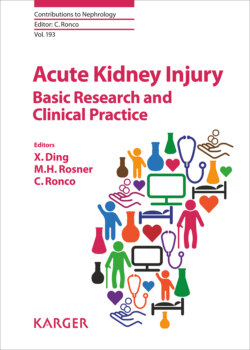Читать книгу Acute Kidney Injury - Basic Research and Clinical Practice - Группа авторов - Страница 15
На сайте Литреса книга снята с продажи.
GFR, eGFR, and RFR
ОглавлениеA persistently reduced GFR implies a diagnosis of chronic kidney disease, whereas an abrupt reduction of the GFR may be used to describe AKI. Therefore, GFR is considered the best overall index of kidney function. Creatinine is the closest to an ideal endogenous substance for measuring GFR, and in case of stable renal function, its levels are usually constant, freely filtered at the glomerulus and not reabsorbed.
GFR can be determined by measuring CrCl using the following simple formula: (urinary creatinine × volume)/(time × plasma creatinine) [20]. Urine collection for 2, 6, 12, or 24 h is required together with the measurement of creatinine concentration in both blood and urine. CrCl tends to overestimate GFR at low levels of renal function [20]. This methodology based on CrCl is clearly time consuming and costly. Nevertheless, as renal function declines, the serum concentration of any solute produced by the body and removed by glomerular filtration will increase proportionally to the rate of GFR reduction: the assessment of serum concentration of such a solute for routine GFR estimation is attractive. Moreover, the development and application of formulae for estimating GFR (and AKI staging) based on creatinine levels is an evident confirmation of the importance of SCr as a renal biomarker.
Therefore, eGFR by creatinine-based equations is commonly used in clinical practice and several options have been proposed [21]. Although GFR and SCr are linked by an exponential relationship and by converting SCr into eGFR allows an easier interpretation of the decline in kidney function, a substantial number of nephrons may already be lost before Scr increases as previously underlined. This crucial issue keeps the eGFR estimation an insensitive marker of kidney function in many clinical conditions. Furthermore, in a non-steady state of renal function, GFR and CrCl cannot be measured reliably due to the rapidly changing parameters, especially in AKI critically ill patients. In this case, the so-called kinetic GFR has been proposed [22]. Some interesting initial applications of this new estimation have been provided in clinical practice even if further validation is currently awaited [23]. Moreover, the capacity of the kidney to respond to physiological demands – the so-called RFR – is another aspect of renal function that requires careful attention and precise monitoring [8]. As a matter of fact, GFR is not constant, but depending on physiological conditions, can change, being dynamic; and like the heart during exercise, GFR can increase to a certain maximum level [8]. The ability of the kidney to increase the GFR under specific stimuli (protein load) is an important property of renal physiology. The KDIGO criteria based on isolated SCr measurements cannot be a valuable system for the assessment of RFR that, in turn, could provide a more sensitive way of assessing renal function [8]. Further research on RFR is currently considered a priority on AKI agenda in order to verify its diagnostic and prognostic value in critically ill patients [1].
